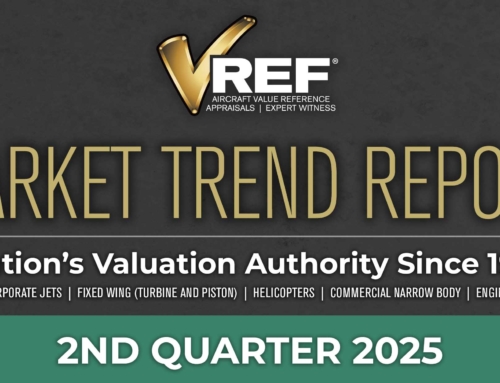As the President of VREF, standing at the helm of an organization that has navigated the skies of the aviation industry for three decades, I’m reminded of the wisdom of Amelia Earhart: “The most difficult thing is the decision to act, the rest is merely tenacity. The fears are paper tigers. You can do anything you decide to do. You can act to change and control your life; and the procedure, the process is its own reward.
This year, as both VREF and I celebrate our thirtieth anniversaries, it’s a moment to reflect on a journey that began when I was a mere 21-year-old and JSSI, a fledgling independent engine maintenance program company. Back then, with only a half dozen employees, surpassing the enrollment of 500 aircraft engines was a distant dream—an ambition that we achieved against all odds.
From those early days, my passion for aviation was not just inherited but deeply ingrained, being a third-generation aviator. My dedication has always been to not only push the boundaries of what VREF can achieve but also to ensure that we leave an indelible mark on the industry for generations to come. Our commitment to enhancing our software and enriching our data offerings is a testament to this vision.
Now, as I stand at another pivotal milestone, feeling both venerable and enlightened, I carry with me three decades of invaluable experiences. These years have been marked by witnessing the ebb and flow of market dynamics, seismic shifts in consumer behavior, and the evolving landscape of aircraft buying, selling, and marketing.
This year’s unseasonably warm winter in the Midwest, with its early onset of spring fever, parallels one of the most unusual market environments we have encountered in decades. Despite the surge in new aircraft deliveries—a nearly 10% increase year-over-year, excluding business jets which saw a modest 2.9% growth—there’s an unmistakable contrast with the burgeoning inventory in the pre-owned market. This juxtaposition is further complicated by the Federal Reserve’s stance on interest rates, which has begun to exert pressure on the market, alongside escalating credit risks.
While the 2023 banking crisis has passed, future challenges loom large for regional and community banks. Profits plummeted in the final quarter of 2023, with significant losses even among larger regional banks that typically outperform smaller counterparts. Net income saw a dramatic drop of about 90% from the previous year among key players in the regional lending sphere, including those specializing in business aviation lending.
Despite a generally lackluster year, 2024 appears fraught with hurdles. Anticipated Federal Reserve rate cuts may not immediately relieve banks. They predict a year-long decline in net interest income, the profit made from loan interests versus what’s paid on deposits. Following the collapse of Silicon Valley Bank and Signature Bank, many had to allocate substantial funds for Federal Deposit Insurance Corp. fees to protect uninsured depositors, in addition to severance costs and provisions for potential loan losses.
Particularly concerning is the high concentration of commercial real estate loans held by regional banks, a sector hit hard by the pandemic-induced office vacancies and exacerbated by persistently high interest rates leading to an uptick in defaults. A report by ATTOM on U.S. Commercial Foreclosures highlighted a significant increase in foreclosures, from a low of 141 in May 2020 to 635 in January 2024, marking a steady rise from the economic uncertainties of the past decade.
As we approach spring and the anticipated summer market slowdown, expectations are set for a continued decrease in post-pandemic values. The financing drought for larger business jets, coupled with economic downturns in Europe and the UK, threatens to worsen the situation. The effectiveness of new bonus depreciation guidelines to boost sales may only slightly stimulate the market as it hinges on the Federal Reserve’s interest rate policies and a looming Presidential election that gets uglier by the day.
A recent Pitchbook report disclosed a 14-year low in venture capital distributions, only surpassed by the 2008 financial crisis. This represents a critical and severe liquidity issue for the venture capital sector, where the sluggish IPO market impedes the flow of returns to investors. Venture capital funds are unable to distribute earnings to their limited partners until they liquidate their investments through mergers, acquisitions, public listings, or secondary sales.
The delayed distributions have led to financial strains among institutional investors, including foundations and endowments, who depend on these returns for operational stability. As you may have seen from a number of SPAC backed aviation startups, as well as the acquisition of numerous companies being consolidated in aggressive manners things are changing as the free flow of cheap money has all but stopped and now these acquisitions must generate profit or face the inevitable chopping block.
The last few years have reaffirmed VREF’s commitment to independence and integrity, serving as a trusted resource for hundreds of thousands of paying subscribers. Governmental oversight and regulatory actions, such as the Corporate Transparency Act and the IRS’s increased scrutiny on business aircraft usage, mark a significant shift towards greater transparency and compliance in aviation. This regulatory action along with the tracking of who owns what, where it is and for how long including the fallout from the Wright Brothers escrow criminal convictions leading to sweeping changes in how aircraft held under trust are bought and sold.
These shifts highlight the need for adaptability and innovation within the industry and accepting that under the current administration government regulation is only going to get worse. The trend of transparency is not going to stop as consumers demand more ethical behavior amidst those jockeying to control an industry.
As we edge closer to a groundbreaking shift in aircraft valuation and marketing intelligence, I’m thrilled to share some information about our latest innovation: an AI-driven software solution poised to transform the landscape of aircraft appraisals and valuations. This cutting-edge tool promises to elevate the precision and speed of aircraft valuations to new heights. Introducing our pioneering VREF Price Index, it stands alone as the first and only tool to monitor both general and business aviation markets.
Drawing from hundreds of thousands of price adjustments in real time, our buyer/seller confidence index uniquely offers real-time, 30-day rolling averages for every aircraft listed across all classified sites. By aggregating this information and cross-referencing it with our proprietary database, including every transaction registered with the FAA and integrating baseline equipment and condition assessments, we’ve developed the market’s most accurate pricing index and evaluation tool. As we approach our launch, stay tuned for more updates on this exciting development and additional features we’re preparing to unveil.
As we look towards the future, let us heed the wisdom of cautious optimism in times of abundance and bold action in the face of adversity. With a vision set on innovation, integrity, and excellence, VREF is poised to shape the future of aviation, elevating the industry to new pinnacles of success. Together, we will continue to chart a course that not only celebrates our rich heritage but also propels us towards a brighter, more innovative future.
In summary, here are the market trends for the 1st Quarter of 2024
– Jason Zilberbrand, ASA
Market Trend: Piston
The winter season traditionally experiences a slowdown in transactions, and this past winter was no exception, marking a slight downturn compared to the previous four years. The average time on the market for listings has increased, leading to many sellers adjusting their inflated asking prices to align with buyer offers. Despite these conditions, the financing market has remained strong, with loan-to-value ratios consistent with previous years. Interest rates have been broadly accepted by buyers, who benefit from an increased inventory that offers more choices and eliminates the urgency to overpay. With the onset of spring, we expect the second quarter to maintain a steady pace in terms of aircraft transactions and pricing, though growth is likely to be minimal.
Market Trend: Piston Twin
The market for twin-piston aircraft continues to face significant challenges, including rising insurance and maintenance costs, alongside operating expenses that are double those of comparable single-engine aircraft. This has made it increasingly difficult for sellers. According to GAMA, new twin aircraft deliveries in 2023 amounted to only 174, in stark contrast to 1,508 single-engine aircraft. Notable exceptions include the DA62, which had a robust delivery year with 66 new units, nearly half of all new twin aircraft, while the Beech Baron G58 saw only five new deliveries. As maintenance costs begin to surpass the aircraft’s value, a further decline in the market for aging piston twins is anticipated.
Market Trend: Turboprops
After a slower fourth quarter, the turboprop market has found stability, particularly for single-engine models, while older twins have seen continued depreciation. Models such as the Caravans, non-NG PC-12s, and TBM 900 series have maintained low inventory levels, indicative of a healthy market. Piper Meridian and M500/M600 models have also seen availability rates that align with historical norms. High demand for the King Air 350 and B200 models has kept their inventory below 3%. The sector benefits from strong OEM support, evidenced by the popularity of models like the Epic and Piper M700, which offer high residual values and appeal to lenders for favorable loan conditions.
Market Trend: Business Jets
The business jet sector is witnessing an increase in inventory, with models like the Challenger 300, 604, 605, Cirrus Vision, CJ1, CJ3, Mustang, and others seeing extended market times. The number of models favored by sellers has decreased, with only a few, including the Challenger 650, CJ4, and Phenom 300, maintaining their market strength. Recent trends show a spike in new listings over the past 30 days, surpassing figures from the previous 90 days. Transaction volumes have halved in January and February compared to the fall, signaling a softening market. Dealers are advised to be cautious with long-term acquisitions as predicting market movements will be challenging, especially with the approaching summer and election period.
Market Trend: Helicopters
The helicopter market has remained stable over the past three months, with transaction volumes and inventory levels balanced. Newer Airbus models have kept their availability below 4%, with stable values. Even older models, such as the 206B3, continue to attract buyers as market prices adjust. The Robinson R44 and R66 variants have seen lower than usual inventory levels, maintaining a seller’s market. Financing remains a hurdle, especially for personal use under part 91, with fewer lenders willing to finance rotorcraft. Utility helicopters, however, tend to perform better in downturns, mirroring trends in the turboprop sector.
Market Demand: Top Locations
Based on VREF Online Access
Domestic
- Dallas, TX
- Ft. Lauderdale, FL
- Miami, FL
- Calgary, AB
- Chesterfield, MO
- Stuart, FL
- Springfield, MO
- Annapolis, MD
- Houston, TX
- White Plains, NY
International
- Bracknell, England
- Toluca, Mexico
- Calgary, AB
- Vienna, Austria
- London, England
- Redhill, Surrey
- Calgary, Alberta
- London, London
- Herne Bay, Ken
- Sao Paulo, Brazil
Market Demand: Top Aircraft
Based on the number of valuations created through VREF Online on a rolling 30-day basis.
Single Piston
- CESSNA SKYLANE 182 A-R
- CIRRUS SR22
- CESSNA SKYHAWK 172 I-M
- CESSNA 150 A-M
- CESSNA SKYHAWK 172 A-H (1956 – 1967)
- BEECHCRAFT BONANZA A36
- CIRRUS SR22T
- CESSNA SKYHAWK 172 N-P
- PIPER CHEROKEE PA-28-180
- PIPER CHEROKEE PA-28-140 B-E
Twin Piston
- BEECHCRAFT BARON 58
- CESSNA 310 B-Q
- BEECHCRAFT BARON 55 A/B
- CESSNA GOLDEN EAGLE 421
- PIPER SENECA II PA-34-200T
- PIPER TWIN COMANCHE PA-30
- BEECHCRAFT BARON 55 C-E
- CESSNA 340A
- DIAMOND DA42 TWIN STAR
- DIAMOND DA62
Turboprop
- BEECHCRAFT KING AIR B200
- PILATUS PC-12/47E NG
- BEECHCRAFT KING AIR 350
- PILATUS PC-12/45
- BEECHCRAFT KING AIR C90B
- PIPER MERIDIAN PA-46 500TP
- BEECHCRAFT KING AIR 250
- BEECHCRAFT KING AIR 200
- CESSNA GRAND CARAVAN 208B EX
- SOCATA TBM 850
Light Jet
- CESSNA CITATION MUSTANG 510
- CESSNA CITATION M2 525
- CESSNA CITATIONJET CJ3
- EMBRAER PHENOM 300
- CESSNA CITATIONJET CJ3+
- CESSNA CITATIONJET CJ4 525C
- EMBRAER PHENOM 100
- EMBRAER PHENOM 300E
- CESSNA CITATION II 550
- CESSNA CITATIONJET 525
Medium Jet
- BOMBARDIER CHALLENGER 300
- GULFSTREAM G200
- BOMBARDIER CHALLENGER 350
- CESSNA CITATION SOVEREIGN 680
- CESSNA CITATION EXCEL 560XL
- CESSNA CITATION XLS
- BOMBARDIER CHALLENGER 605
- CESSNA CITATION XLS +
- HAWKER 800XP
- GULFSTREAM G280
Large Jet
- GULFSTREAM G550
- GULFSTREAM G450
- BOMBARDIER GLOBAL 6000
- BOMBARDIER CHALLENGER 604
- BOMBARDIER GLOBAL EXPRESS 5000
- FALCON 7X
- GULFSTREAM G650ER
- GULFSTREAM GIVSP 1159C
- BOMBARDIER GLOBAL EXPRESS XRS
- GULFSTREAM GV
Helicopter
- ROBINSON R44 RAVEN II
- ROBINSON BETA R22
- ROBINSON R44 RAVEN I
- GUIMBAL CABRI G2
- ROBINSON R44 RAVEN
- ENSTROM F-28F FALCON
- SIKORSKY 300C 269C





